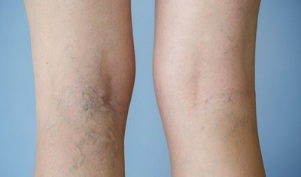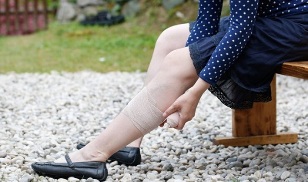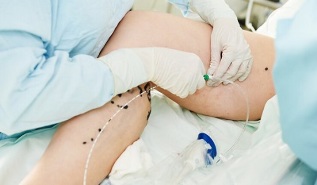
Signs of varicose veins are often found in women - this pathology is found in almost every third woman. This disease, accompanied by an enlargement of the lumen and thinning of the walls of venous vessels, leads not only to the appearance of cosmetic defects, but is also associated with pain and malnutrition of the tissues of the lower extremities. As a result, if left untreated, a woman can develop trophic leg ulcers, which lead to even more serious complications. This is why the start of varicose vein treatment should always be on time.
Signs of varicose veins in women are not always visible in the early stages - sometimes the disease lasts for a long time.Early causes and signs
Varicose veins in the legs are affected by varicose veins under the influence of the following factors:- overweight; inheritance
- ;
- sedentary lifestyle;
- long stay in a static position;
- pregnancy;
- birth of a child;
- taking high-dose contraceptives;
- increased abdominal pressure with frequent or prolonged coughing, sneezing or constipation;
- overload during physical exercise or exertion;
- foot injuries;
- pelvic pathology;
- excessive use of radiation or thermal treatments;
- wearing uncomfortable shoes;
- the habit of sitting cross-legged;
- alcohol abuse;
- old age
Due to increased pressure in the venous vessels and blood clots, the vessels dilate, the blood flow in them changes direction and speed of flow, as the vessel walls change their tone, and the valves stop functioning normally. As a result, changes in the veins lead to the development of a vicious circle in the hemodynamics and other functions of the venous vessels.
In the early stages of varicose veins, blood flow can still be compensated for by conservative means - compression footwear, gymnastics and the use of venotonics. However, as the disease progresses, changes in the structure of the veins become irreversible and can only be removed surgically.
Symptoms of varicose veins can significantly disrupt the normal rhythm of life.
The following manifestations may become the first signs of varicose veins in the legs:

- standing weight;
- appearance of telangiectasias - spider veins and nets of different colors (bluish, red, black);
- feeling of fullness during a long stay in a stationary position (sitting, standing);
- convulsions at night;
- relief of symptoms after walking or resting in a horizontal position.
Often, the first manifestations of this common disease are attributed to fatigue, and a visit to the doctor can be postponed until the serious consequences of the disease appear. As the venous wall expands, the symptoms become more pronounced, and then new ones appear in the above manifestations.
Symptoms
Varicose veins in later stages is manifested by the following symptoms:
- rapid fatigue in the legs;
- pain;
- feeling full of juice;
- soft tissue swelling after exertion;
- transparency and elongation of large veins on the skin;
- itchy skin;
- bruising due to rupture of large vessels;
- peeling skin;
- hair loss;
- trophic ulcer.
Against the background of varicose veins in women in the lumen of the veins, blood clots can form - thrombi. When they migrate through the bloodstream, consequences of varying severity develop: thrombosis, phlebothrombosis, the development of cardiovascular disease, the opening and emptying of ulcers, the entry of blood clots into the vessels of the heart or lungs.
Diagnosis and treatment
To confirm the diagnosis, a woman should contact a vascular surgeon and undergo an examination. The diagnostic plan includes an examination with instrumental studies:
- Doppler ultrasound of the vessels of the foot;
- angioscanning duplex;
- reovasography;
- X-ray and radionuclide methods.
Tactics for treating varicose veins of the legs are determined by the stage of the disease. Conservative tools can be used early:
- wearing compression stockings or bandaged with elastic bandages;
- sufficient physical activity;
- wearing comfortable shoes;
- physiotherapy exercises;
- elimination of static load on the foot;
- application of venotonics.
The duration of conservative therapy is individual and depends on the degree of disease progression and compliance with the doctor's recommendations. It can be supplemented with a special diet, implying the introduction of foods into the diet that help strengthen the walls of blood vessels.
The possibility of varicose veins receding under the attack of conservative treatments is determined by each clinical case. In many ways, the success of therapy depends on the timing of a visit to a doctor.
Also, these therapies are recommended in the preparation phase for surgical treatment or for those patients who are contraindicated for invasive intervention.
Sometimes preventing the progression of varicose veins can consist of performing minimally invasive interventions. They are applicable only to strict indications, which are determined during the examination of the patient.
Treatment of varicose veins in advanced stages usually involves performing a surgical operation - minimally invasive or classic.

If possible, a woman is recommended radical treatment of varicose veins of the legs:
- compression sclerotherapy;
- laser coagulation;
- photocoagulation;
- radio frequency coagulation.
If the impact of these minimally invasive techniques is not sufficient, then for more radical surgical treatment, classical operations are performed:
- miniflebektomi;
- phlebectomy;
- Trendelenburg Method (with complications from thrombosis and infection).
Sometimes classical surgical techniques are complemented by the use of minimally invasive ones. This combination can reduce the trauma of operations and shorten the postoperative rehabilitation period.
Varicose veins of the lower extremities can be successfully treated, especially in the early stages. This is why the first signs of this disease should always become a reason to visit a vascular surgeon. Varicose veins can occur at different ages and observations show that women are more likely to suffer from this disease. The signs of varicose veins in women are the same as in men.




































